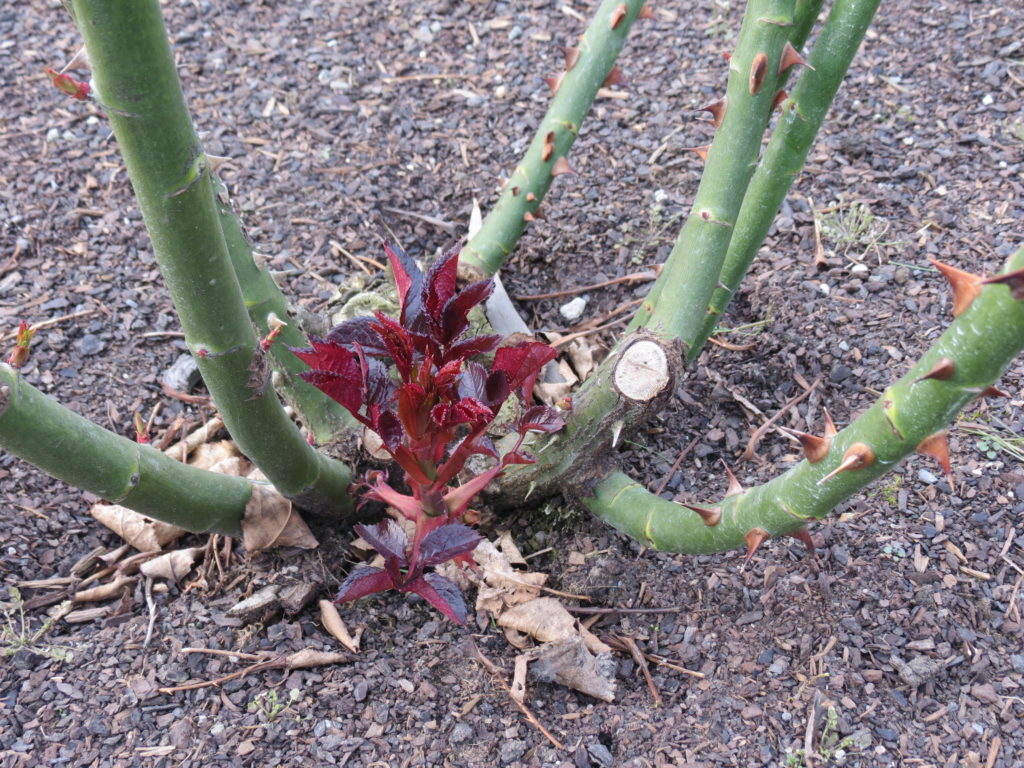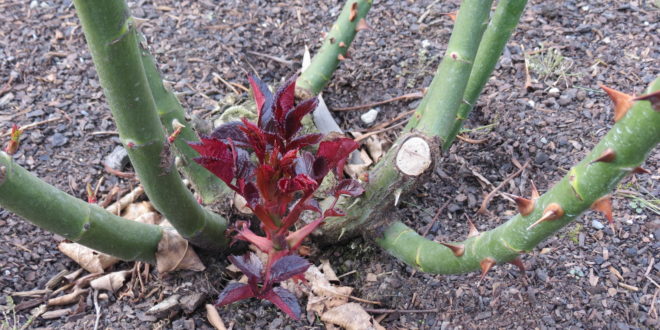Hopefully, by now your pruning has been completed and your roses are starting to shoot into new growth ready for the flowering season ahead. It is also the time where we will see new growth come away from the base of the plant but it is important to know what type of growth you have.
Basal shoots
Basal shoots (also referred to as water shoots by some references) are those shoots that emerge from the bud union of plants and are characterised by their reddish colour and their soft, sappy nature.

In rose culture, basal shoots are very important, as they are the means by which our rose plants keep rejuvenating themselves, otherwise, our plants will become less productive and vigorous as the canes get older. Some varieties freely produce basal shoots while others are quite stingy, only putting one up every two or three years.
Basal shoots can be encouraged by giving the bud unions of our roses a light scratch around with a wire brush to remove any excess bark that might be preventing new basals from developing underneath, although take care as any buds can be damaged with the wire brush. Also, make sure you cut any canes you are removing right back to the bud union, don’t leave stubs which will die back.
As many rosarians will testify, its one thing to get basal shoots, it’s another thing to keep them, as many are lost to our wild spring winds. Going around the garden picking up basals that have blown out in recent strong winds must be one of the most heartbreaking things for a rosarian.
To help prevent this type of damage, basals should be staked and tied up, but not too tightly to allow some movement of the shoot. The top of basal shoots can also be pinched out when they are around 50cm long as this encourages branching and more blooms.
Some people cut their basals off just because they don’t like the look of them – don’t! Also, some gardening references tell us that we must cut our basals off as well – this is incorrect.
Suckers
Suckers are often confused with basal shoots but unlike them, they are undesirable in rose culture and must be controlled. They are only a problem with budded (grafted) roses as everything that grows from cutting grown roses are the cultivar itself.
They are the growth of the rootstock onto which the rose was budded and in New Zealand, almost all roses are budded onto Rosa multiflora rootstock. Because the rootstock is very vigorous, the suckers will grow at the expense of your desired plant and if not controlled, they will weaken it and take over completely.
There are a number of key differences between basal shoots, which makes identification easy. Firstly, suckers grow from below the bud union while basal shoots grow from the bud union. Suckers can also be identified by the lack of thorns on the stems, the leaf colour, which is a lighter green and the number of leaflets, which is 7-9 per leaf (most rose cultivars have 5 leaflets per leaf).
There is little you can do to prevent suckers from occurring and usually doesn’t show up in new season’s roses until September.
It is a problem that can be traced back to the nursery and how the rootstock cutting was prepared. In most cases, all the ‘eyes’ or buds along a cutting are removed by hand except for the top two, which allows the cutting to grow until it is budded and then the top is cut out. However, this process is not perfect and some can be missed which result in suckers forming later on down the track, although generally, it is a minor problem
To remove suckers, scrape away the soil from around your rose to locate where the sucker is originating (remembering that basal shoots originate from the bud union and suckers from anywhere beneath this. It is best to pull the suckers off although you also can cut them off with a sharp knife, but try and get as close to the stem as possible as some buds can be left to grow at the base. Keep an eye on your plant(s) in case the suckers regrow.
In conclusion, basal shoots are to be encouraged and suckers discouraged when growing roses.
In the rose garden for September
- Apply fertiliser at the recommended rates this month. Apply away from the crown of roses and water in well for best results.
- Apply mulch to your roses. There is a vast range of materials around to use. Keep mulch away from the crowns and for the likes of bark, make sure it is well composted before use.
- Keep an eye on new growth coming away and cut back any stems that the buds fail to come away.
By Hayden Foulds
Hayden also serves as Deputy Chairman of the World Federation of Rose Societies Rose Trials Committee amongst other rose endeavours.










Join the Discussion
Type out your comment here:
You must be logged in to post a comment.